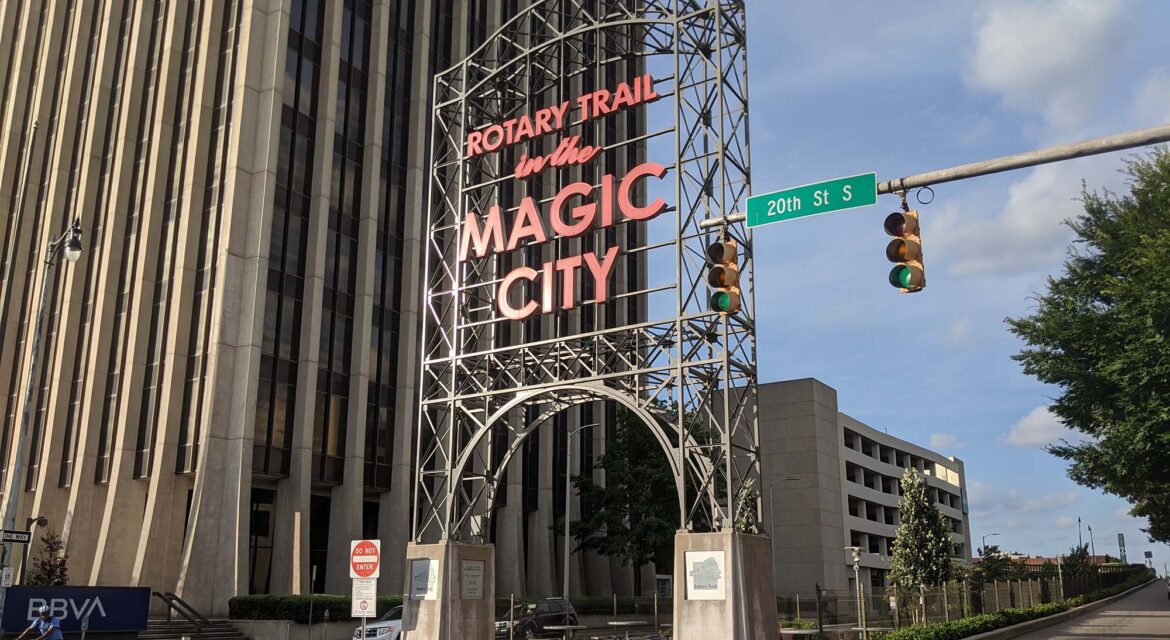 A prominent “Rotary Trail in the Magic City” sign welcomes visitors to the linear park in downtown Birmingham, Alabama. It’s the most notable element of a greenspace that has transformed what was an abandoned railroad cut into a park that attracts both residents and visitors. However, that sign is just one element of the Rotary Trail, which connects the past with the present of the city to positively redefine the Birmingham community in multiple ways.
A prominent “Rotary Trail in the Magic City” sign welcomes visitors to the linear park in downtown Birmingham, Alabama. It’s the most notable element of a greenspace that has transformed what was an abandoned railroad cut into a park that attracts both residents and visitors. However, that sign is just one element of the Rotary Trail, which connects the past with the present of the city to positively redefine the Birmingham community in multiple ways.

The Magic City
 As the Rotary Club of Birmingham began to approach the club’s 100th anniversary in 2013, the group began to discuss what would make for a fitting centennial project. A vacant railroad right-of-way, or “cut,” was an eyesore for the downtown area, providing the group with an opportunity to change what had been a neglected part of Birmingham into a tranquil four-block walking/running/biking pathway. The Rotary Trail was designed to be transformational but also serve as a legacy gift to the city of Birmingham.
As the Rotary Club of Birmingham began to approach the club’s 100th anniversary in 2013, the group began to discuss what would make for a fitting centennial project. A vacant railroad right-of-way, or “cut,” was an eyesore for the downtown area, providing the group with an opportunity to change what had been a neglected part of Birmingham into a tranquil four-block walking/running/biking pathway. The Rotary Trail was designed to be transformational but also serve as a legacy gift to the city of Birmingham.
The sign at the entrance that reads, “Rotary Trail in the Magic City” was a major part of this transformation. The design of it is a tribute to the iconic Magic City sign which one stood outside Terminal Station in downtown Birmingham. This connection to the city isn’t one that simply extends to the past though. The 19-acre Railroad Park and the Sloss Furnaces area are now linked in the present thanks to the Rotary Trail. In doing so, it has also bridged different communities in downtown Birmingham that will be strengthened by future improvements and expansions to the trail.
These connections are the foundation of the economic benefits for the whole downtown that the Rotary Trail has enabled. All of these benefits are built on the experiences and benefits that the Rotary Trail has directly facilitated for individuals and for the entire community.

Changing Birmingham for the Better
Prior to the development of the trail, the storm water run-off in the railroad cut flowed directly into Village Creek, carrying debris and other pollutants into the city’s water system. With the development of the trail, a new filtration system was put in place to improve the quality of the run-off in the right-of-way.
 These developments aren’t just about infrastructure improvements though. The Rotary Trail has provided residents with a place where they can jog, walk or relax. The history and serenity of the trail have also proven to be an attraction for visitors as it also allows them to experience the culture of the city.
These developments aren’t just about infrastructure improvements though. The Rotary Trail has provided residents with a place where they can jog, walk or relax. The history and serenity of the trail have also proven to be an attraction for visitors as it also allows them to experience the culture of the city.
Pieces of public art like “Frank’s Table”, which was commissioned in honor of Frank Stitt to serve as an invitation for everyone in the Birmingham community to sit together, are placed throughout the Rotary Trail. Other pieces like “Susan’s Bird” have also been incorporated into the park, which features plenty more space to see an expansion of this sort of artwork.
These pieces along with markers that celebrate the contributing corporations & foundations that made the Rotary Trail possible connect audiences to the Birmingham community. They are subtle examples of how the space has been changed for the better but they’re also just the start of even bigger changes.
Connecting Birmingham Across the Eras
 Numerous urban parks have transformed rail lines and other pieces of dilapidated infrastructure into destinations, but the transformation that the Rotary Trail has enabled is just the beginning for changes in downtown Birmingham. Extensions that will make it part of the Red Rock Trail System are ongoing and the economic ramifications of these developments were a major consideration for the Rotary Club. The trail was designed as a link within a larger trail system that has already connected major parts of the city. These connections are also set to be expanded in numerous ways.
Numerous urban parks have transformed rail lines and other pieces of dilapidated infrastructure into destinations, but the transformation that the Rotary Trail has enabled is just the beginning for changes in downtown Birmingham. Extensions that will make it part of the Red Rock Trail System are ongoing and the economic ramifications of these developments were a major consideration for the Rotary Club. The trail was designed as a link within a larger trail system that has already connected major parts of the city. These connections are also set to be expanded in numerous ways.
The Rotary Trail highlights not only what it can mean for an organization to drive and enable such major change but also how doing so can literally and symbolically connect an entire city across multiple eras.


